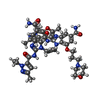+Search query
-Structure paper
| Title | Structural insights into a shared mechanism of human STING activation by a potent agonist and an autoimmune disease-associated mutation. |
|---|---|
| Journal, issue, pages | Cell Discov, Vol. 8, Issue 1, Page 133, Year 2022 |
| Publish date | Dec 13, 2022 |
 Authors Authors | Zuoquan Xie / Zhen Wang / Fengying Fan / Jinpei Zhou / Zhaoxue Hu / Qingxia Wang / Xiyuan Wang / Qingzhong Zeng / Yan Zhang / Jiaxuan Qiu / Xiaoqian Zhou / Hui Xu / Hudagula Bai / Zhengsheng Zhan / Jian Ding / Huibin Zhang / Wenhu Duan / Xuekui Yu / Meiyu Geng /  |
| PubMed Abstract | Stimulator of interferon gene (STING) is increasingly exploited for the potential in cancer immunotherapy, yet its mechanism of activation remains not fully understood. Herein, we designed a novel ...Stimulator of interferon gene (STING) is increasingly exploited for the potential in cancer immunotherapy, yet its mechanism of activation remains not fully understood. Herein, we designed a novel STING agonist, designated as HB3089 that exhibits robust and durable anti-tumor activity in tumor models across various cancer types. Cryo-EM analysis reveals that HB3089-bound human STING has structural changes similar to that of the STING mutant V147L, a constitutively activated mutant identified in patients with STING-associated vasculopathy with onset in infancy (SAVI). Both structures highlight the conformational changes of the transmembrane domain (TMD), but without the 180°-rotation of the ligand binding domain (LBD) previously shown to be required for STING activation. Further structure-based functional analysis confirmed a new STING activation mode shared by the agonist and the SAVI-related mutation, in which the connector linking the LBD and the TMD senses the activation signal and controls the conformational changes of the LBD and the TMD for STING activation. Together, our findings lead to a new working model for STING activation and open a new avenue for the rationale design of STING-targeted therapies either for cancer or autoimmune disorders. |
 External links External links |  Cell Discov / Cell Discov /  PubMed:36513640 / PubMed:36513640 /  PubMed Central PubMed Central |
| Methods | EM (single particle) |
| Resolution | 3.47 - 3.65 Å |
| Structure data | EMDB-34244, PDB-8gsz: EMDB-34245, PDB-8gt6: |
| Chemicals |  ChemComp-WJ6: |
| Source |
|
 Keywords Keywords | IMMUNE SYSTEM / mutant / SAVI-related / Agonist / Human STING |
 Movie
Movie Controller
Controller Structure viewers
Structure viewers About Yorodumi Papers
About Yorodumi Papers







 homo sapiens (human)
homo sapiens (human)